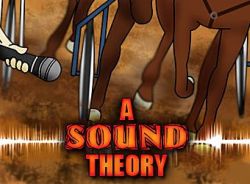A Sound Theory
July 19, 2010,by Bob Carson
Editor’s Note: The USTA website is pleased to present freelance writer Bob Carson and his popular “Outside the Box” features. This monthly series is a menu of outlandish proposals presented with a wink — but the purpose behind them is serious. The views contained in this column are that of the author alone, and do not necessarily represent the opinions or views of the United States Trotting Association.
“Words represent your intellect. Sounds, gestures and movement represent your feelings.” — Patricia Fripp

Bob Carson
In 2005 I made a movie titled Touching Home. The theme was an over-the-shoulder glimpse at a trio of professional baseball players as they tried to climb the ladder that leads to the Major Leagues.
Okay, it was a low budget documentary. Okay, I paid a professional filmmaker to do the bulk of the technical work. Okay, my main jobs were making arrangements, toting around equipment, fetching coffee and writing checks.
The project took exactly one year between waking up with the idea and picking up 1,000 copies of the finished movie. It was a terrific adventure. Every day in the movie world was a learning experience. This may sound silly but making a movie was both surprisingly simple and incredibly complex.
One of the more complex items was a part of the film project I took for granted…the sound. Without a doubt, this was the most difficult part of the film and consequently the weakest part of the movie (it did not help that the professional sound person we planned on hiring had the bad taste to have a heart attack).

Autumn Ryan graphic
Sound, in the presentation of any entertainment, is critical. Harness racing is not doing a good job of exploiting the wonderful sounds of our game that could add drama to racing. We have a lot of room for improvement across the board; at the racetrack, on our television screens and with our computer feeds.
I am not talking about our harness racing announcers. Most of the folks calling the races are outstanding (how do these announcers find eight horses, twice, and four split times in each race when I often lose sight of the one horse carrying my cash). I’m talking about pounding hoofs, yelling drivers, cracking whips, creaking wheels, subliminal music, audio cues, and sound effects.
Try this experiment. Listen to a movie, a complete movie, or even a TV show blindfolded. Really concentrate for an extended period of time. It’s amazing. Great sound people lead you like a yearling on the lead shank. They make you feel a range of emotions. Normally, you are not even aware of the manipulation. You can try the flip side of this experiment, watch a film without sound and the experience falls flat.
People are more inclined to desire a product that has a connection with music and sounds they enjoy rather than one that has been paired with unappealing music or no music at all. Consumers are more likely to buy products aligned with particular sounds and music. It is no secret that sound and music both affect consumer behavior. Research has found that loudness, tempo and genre — each has a significant effect on how individuals interpret an experience.
Experiments found that in both supermarkets and restaurants, slower music saw significantly higher overall sales volumes, with one supermarket study reporting an increase in sales of 38 percent in stores with slow music conditioning. This is not surprising, as consumers who are moving more slowly are more inclined to see additional items they may purchase.
Restaurants playing slow music had longer waits for tables and much higher customer bar bills. Interestingly, although restaurant patrons did not eat more in the slow music condition, they drank far more. This, of course, works the opposite way. Exciting noise, music and crowd reaction stimulate and validate entertainment and sporting experiences.
Sound does make a difference, more than most of us imagine.
Those of us foolish enough to have had a seat in a sulky during a race have a sense of the drama and audio cues that wash over the sulky. Most people in the grandstands or sitting in front of a television or computer monitor watching a horse race have not had this experience. They should. We need to give the sounds of a live race to them and racing sounds should be a much more important part of our packaging.
The costs would be minimal. Microphones can be as small as buttons on a shirt. They can be attached with Velcro. They are wireless. Simply attach microphones on the harnesses of the horses and a sound engineer will pick up the feed.
It will take talent, practice and innovation, but a clever posse of sound engineers will eventually find a way to weave magic out of a horse race. The sounds should be carefully integrated with our announcers. It is not out of the question, to have the live action on the track synchronized with subtle musical scoring.
We have so many assets in harness racing. Sound is a dimension of our presentation where we have been deaf for too long.
